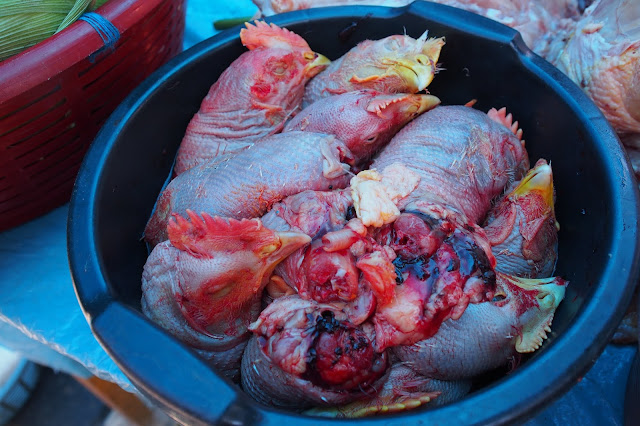Panajachel (“Gringotenango”), Guatemala January 26-28, 1979
The bus ride from Antigua to Panajachel was relatively short – 3 hours or so – with a change at Chimaltenango, a little town I’d like to get back to... . We traveled through a landscape of rolling hills, virtually all of which are cultivated (it is truly amazing how anything can be cultivated on such steep a slopes!) by indigenous farmers. Their homes – little adobe or cane (grass?) walled huts with corrugated tin rooves – or no rooves at all.
The bus – an old Bluebird school bus, no longer considered fit for use in the USA, and so shipped to this and other countries where they ‘enjoy’ a new life, at least of sorts. As usual the bus was just packed with gringos and Indios. The indigenous men and young boys were clad in brightly coloured (mostly red and orange-striped, with some purple, blue and green) shirts and pants, red woven sashes at the waist, and a heavy brown and black houndstooth-patterned wool skirt, about 18” wide, wrapped around their loins. Many sported nicely fitted brown, black and white wool jackets adorned with black embroidery. And almost all wore hats – either big black bowler-type hats or battered and dirty white straw or grass hats.
The women wore woven and/or embroidered huipiles of all colours and designs, some more geometric, some more naturalistic (flowers, birds, animals). Their skirts, again often of woven multi-coloured fabric, but sometimes solid black or very dark blue, were long and wrapped around their hips, gathered securely at the waist by a coloured sash or tie. Sometimes they wore another coloured over-shirt, especially over the plainer red huipiles. They fashioned their long, black hair into two thick braids, interwoven with coloured cloth ribbons and tied at the bottom, making a loop. Or sometimes their braids would be wound around the top and sides of their head, making a handy cushioned base for their brightly coloured and very heavy bundles. Always, around their shoulders, another brightly coloured – usually orange and red – shawl to carry babies, groceries, or firewood on their backs.
Although their lives are clearly hard, even harsh, the indigenous people of Guatemala appear happy. They are almost always smiling, and very friendly and courteous, both with us and with one another. They love their children, and treat them with great gentleness and affection. I wonder if there are lessons to be learned here about living a simpler life. Which of the many conveniences I enjoy in my everyday life – reliable sources of water and electricity, my own personal transportation, access to entertainment, a social life – which of these would I be willing to give up, even for a short time? It’s all well to idealize and romanticize about the simple ‘peasant’ life: it’s another thing to have no other choice but to live it.
Panajachel is not very big, but it's a pretty busy place. It’s often referred to, by gringos and locals alike, as ‘Gringotenango’ in reference, of course, to the large numbers of gringos who make this their home for varying periods of time – either just passing through or permanently encamped (it seems that visas can either be easily extended or no one is checking...). The gringos compete with the locals for colour, wearing equally brightly coloured jackets, shirts, pants, skirts and shawls, or scarves. Most of us – women and men alike – have long hair, and most of the guys have beards. Some of us look pretty scruffy, even desperate, living and traveling on shoestrings (I have my copy of “South America on a Shoestring” in my backpack). But in an odd way we ‘fit in’, and are accepted by the locals. If nothing else they like our money.
The markets here – in Pana and up the road in Solala – are fabulous. Wonderful fruits and vegetables. Bananas, oranges, avocadoes, cucumbers, tomatoes, potatoes of all colours. Plenty of fish, mostly little. Live chickens and bowls of chicken heads or feet. And lots and lots of flowers. But what catches my eye, always, are the women vendors, the mamacitas in their colourful huipiles, dresses and aprons. And the liveliness of it all – so much going on. I’m developing a thing for markets. I could spend days in them just watching the goings-on. I take a few photos, trying to be sensitive to those who are clearly not comfortable having their pictures taken. I don’t want to be like so many tourists I see here, pointing big telephoto lenses at people, then not acknowledging them at all – not so much as a hello, a nod or a thank-you. And certainly not a ‘may I?’
There’s a terrific bakery in Pana, ‘La Tienda’, run by a couple of gringos, that makes great whole wheat bread, and that serves up yogurt, fruit and granola all day. And fresh, hot banana bread at 3 pm....mmmmm. It’s a favourite hang-out for gringos – a place to meet up and compare notes about places here in Guatemala, as well as travel tips for Colombia, Ecuador, Peru, Bolivia, and Chile. A place to find others to travel with, or just have conversations about what’s happening in the world we’ve left behind. It’s at Mama’s that I hear about San Lucas Toliman, a town across the lake from Panajachel that’s a little smaller, a little quieter, and a little less gringo-ized. I’m going to go to the bank here and get some provisions, then head there, by bus, tomorrow.













Comments
Post a Comment